World War II
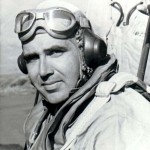
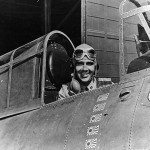 It takes many different kinds of soldiers, foot soldiers, seamen, and airmen, to win a war. One group supports the others, and without all of them, winning a war in modern times would be next to impossible. Partly because my dad fought in World War II, I find myself most interested in that war. I am very proud of the part my dad played in shooting down enemy aircraft from his position as top turret gunner, and along with his crewmembers, providing air support for ground missions. Of course, many of the heroes who are remembered in a war, are the men in the little fighter planes. The fighting they do is very dramatic, and watching movies or documentaries about the planes they shoot down is exciting. We know of the dangers they face every time they take off, and that adds to the amazement when they are successful.
It takes many different kinds of soldiers, foot soldiers, seamen, and airmen, to win a war. One group supports the others, and without all of them, winning a war in modern times would be next to impossible. Partly because my dad fought in World War II, I find myself most interested in that war. I am very proud of the part my dad played in shooting down enemy aircraft from his position as top turret gunner, and along with his crewmembers, providing air support for ground missions. Of course, many of the heroes who are remembered in a war, are the men in the little fighter planes. The fighting they do is very dramatic, and watching movies or documentaries about the planes they shoot down is exciting. We know of the dangers they face every time they take off, and that adds to the amazement when they are successful.
During World War II, to acquire Ace status, a fighter had to shoot down five enemy planes. On February 20, 1942, the United States received it’s first Flying Ace of World War II. His name was Lieutenant Edward O’Hare. O’Hare was a US Navy fighter pilot with the Fighting Squadron 3, aboard the USS Lexington. The Lexington, sailed into the Coral Sea in mid-February, 1942. Then on February 20th, as the Lexington neared Rabaul, Japanese radar picked up the ship. Japanese bombers headed straight for it. O’Hare and his team went into action. They were piloting F4F Wildcats. In just four minutes, O’Hare shot down five Japanese G4M1 Betty bombers. This ended the Japanese attack and O’Hare became an Ace. It also ended the planned raid, because the element of surprise was gone. O’Hare was awarded the first naval Medal of Honor awarded in World War II. He was a great shot, but on November 26, 1943, his luck ran out. His plane was shot down during a nighttime fighter attack near the Gilbert Islands. It was never found. In 1945, the Navy named a destroyer the USS O’Hare after him. Later, Chicago’s Orchard Depot Airport was renamed, O’Hare international Airport after him.
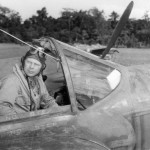
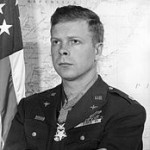
O’Hare was the first ace of World War II, but he was not the Ace with the most kills in World War II…that honor belongs to a man born in the same town I was…Superior, Wisconsin. Richard Bong shot down 40 enemy aircraft before he was killed on August 6, 1945 over North Hollywood, California, while testing a P-80A jet. The plane exploded causing Major Bong’s death. The flying aces of World War II were many…too many to name here, but among the notables are Edward O’Hare, Richard Bong, and Chuck Yeager. All the aces were heroes.
 Imagine a people so dedicated to bringing their people home to be given a proper burial, that they would search for 31 years for a submarine that went missing with its 69 crew members, all considered lost sons of a nation. I know that many people wait years and never give up hope for the return of the remains of soldiers lost in battle, but this was a little bit different. The meant extensive searches and great expense…nevertheless, it was considered worth the cost. Imagine such a nation. Who would you think of? The United States maybe, or England? No, it is Israel.
Imagine a people so dedicated to bringing their people home to be given a proper burial, that they would search for 31 years for a submarine that went missing with its 69 crew members, all considered lost sons of a nation. I know that many people wait years and never give up hope for the return of the remains of soldiers lost in battle, but this was a little bit different. The meant extensive searches and great expense…nevertheless, it was considered worth the cost. Imagine such a nation. Who would you think of? The United States maybe, or England? No, it is Israel.
The submarine, INS Dakar was originally known as HMS Totem. It was built at the height of World War II by H.M. Dockyard in Great Britain. It was commissioned as the HMS Totem by the British navy in 1943. After the war ended, the submarine was modified, adding 12 feet to its length and removing some of its gun decks. The submarine was then sold to Israel along with two others in 1965. On November 10, 1967, the Israeli Navy officially launched Dakar. The submarine was tested in Scotland, and scheduled to go to Haifa, Israel for an official ceremony in early February, 1968. The crew had been ordered to check in daily, and they followed the orders implicitly. On January 24, 1968, Dakar passed the island of Crete and radioed its position for the last time. One additional signal came from Dakar just after midnight on January 25, 1968 and then…nothing. That was 48 years ago today.
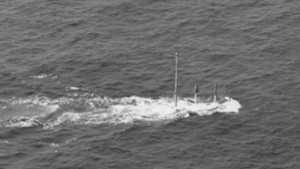
Israel launched 25 search missions over the 31 years following the loss of Dakar, but to no avail. The only sign of the submarine was one of her locator buoys that washed ashore off the coast of Khan Yunis a year after Dakar’s disappearance. Using that clue and the technology available at the time, those search missions resulted in the search of most of the Mediterranean Sea. The odd thing was that the searches never included the actual route that Dakar would have taken to Haifa. When the buoy was discovered, it was estimated that Dakar was 50 to 70 miles off course…hence the searches in the wrong places. Then, on 9 May 1999 two charted sea vessels arrived to finally search area along the original route. The designated search frames box area was approximately 60 nautical miles long, nearly 8 nautical miles wide and contained 16 search lanes. With a speed of 2 knots per hour it takes between 30 to 40 hours to monitor the sea bed of each search lane. Searching was conducted using the AMS-60, a wide-swath sonar and the REMORA 6000, a remotely operated vehicle equipped with both video and still cameras. On May 24th, in the evening, sonar detected a large body on the sea floor, along with several smaller bodies nearby. They launched the ROV at 7:00 on May 28th, after 3 days of weather delays, and finally found the Dakar four hours later.
There has been much speculation as to what caused the sinking and inevitable implosion of Dakar. Some say it 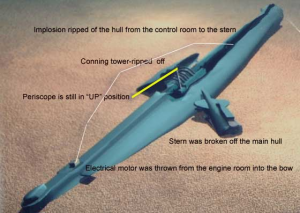 was a small leak that made control become impossible, but one Egyptian admiral has a different story to tell. Mohammed Abed el-Majid Azeb told various Egyptian sources that his crew identified the Israeli submarine during a training exercise. He decided to attack the vessel, which was in Egyptian territorial waters and and declared war on it. According to the report, Egyptian military commentators have suggested that the submarine was damaged by an Egyptian depth-charge and had to submerge, which could have been the leak they experienced. It’s hard to say after all these years, and we may never know, but I find it very interesting that the Israeli government would not give up until it could bring those lost sons home for a proper burial.
was a small leak that made control become impossible, but one Egyptian admiral has a different story to tell. Mohammed Abed el-Majid Azeb told various Egyptian sources that his crew identified the Israeli submarine during a training exercise. He decided to attack the vessel, which was in Egyptian territorial waters and and declared war on it. According to the report, Egyptian military commentators have suggested that the submarine was damaged by an Egyptian depth-charge and had to submerge, which could have been the leak they experienced. It’s hard to say after all these years, and we may never know, but I find it very interesting that the Israeli government would not give up until it could bring those lost sons home for a proper burial.
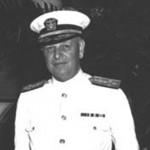 It seems that whenever something goes wrong in our world, someone must be to blame, and I believe that is often the case. The problem with playing The Blame Game, is that all too often, the person where the real blame should go is not the one who ends up taking the fall. Scapegoats have been around since Bible times, when the sins of the people were placed on a goat and it was sent into the windernesss. That isn’t the type of scapegoat that we see today, however.
It seems that whenever something goes wrong in our world, someone must be to blame, and I believe that is often the case. The problem with playing The Blame Game, is that all too often, the person where the real blame should go is not the one who ends up taking the fall. Scapegoats have been around since Bible times, when the sins of the people were placed on a goat and it was sent into the windernesss. That isn’t the type of scapegoat that we see today, however.
Don’t get me wrong, we all play The Blame Game, but politicians seem to be particularly adept at it. A good example is the forced retirement of Rear Admiral Husband E Kimmel, who was relieved of his command of the United States Pacific Fleet on December 17, 1941, just ten days after the Japanese attack on Pearl Harbor. I don’t say that he bore no blame at all, but in reality, he had no more reason to think that an attack on Pearl Harbor was imminent, than anyone else had. And in reality, the blame needed to fall on our President at the time, Franklin Delano Roosevelt, because he was soft on the Japanese, and basically asked us to trust them, when they were not at all 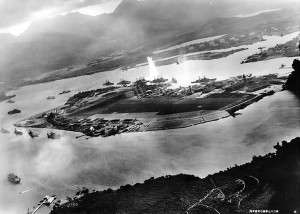 trustworthy. President Roosevelt’s actions…or lack thereof, left us sitting ducks when the Japanese made their move.
trustworthy. President Roosevelt’s actions…or lack thereof, left us sitting ducks when the Japanese made their move.
Basically, Rear Admiral Kimmel was chosen to take the blame because of his lack of imagination…or so it was said. Kimmel was a creature of habit, and he had expected an attack on Midway Island or Wake Island, and even went so far as to request extra antiaircraft artillery be sent there. None could be spared, and so was not sent. It never occurred to him that the Japanese might attack Pearl Harbor, and therefore he took no special action there. Unfortunately, Kimmel was an easy read by the Japanese, and when he chose not to protect Pearl Harbor, that was where the Japanese made their attack. But, as I said, he had no more reason to expect an attack at Pearl Harbor than anyone else had, and for that reason he should not have born the brunt of the blame.
Kimmel could have faced court martial…a second and even more severe injustice…but in the end, when he requested early retirement, his request was granted. The American people were outraged at this breach in 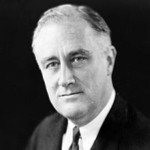 security, so someone had to take the blame. I really find that to be an unfair way to handle this situation, but it was how it was done anyway. When Admiral Kimmel’s Story, which was an “as told to” autobiography, was published in 1955, the admiral made it clear that he believed President Roosevelt sacrificed him, and his career, to take suspicion off himself. Although there was no evidence to prove it, Kimmel believed Roosevelt knew Pearl Harbor was going to be bombed. I’m not sure Roosevelt could have known that either, but I think he was just as much or more to blame than Kimmel was. There always seems to be enough blame to go around, but in reality, trusting our enemies will always bring bad results. We need to be watchful and strong in military might to keep this nation safe.
security, so someone had to take the blame. I really find that to be an unfair way to handle this situation, but it was how it was done anyway. When Admiral Kimmel’s Story, which was an “as told to” autobiography, was published in 1955, the admiral made it clear that he believed President Roosevelt sacrificed him, and his career, to take suspicion off himself. Although there was no evidence to prove it, Kimmel believed Roosevelt knew Pearl Harbor was going to be bombed. I’m not sure Roosevelt could have known that either, but I think he was just as much or more to blame than Kimmel was. There always seems to be enough blame to go around, but in reality, trusting our enemies will always bring bad results. We need to be watchful and strong in military might to keep this nation safe.
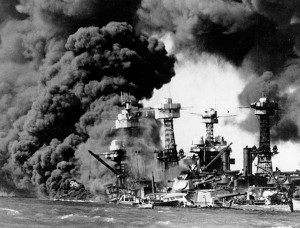
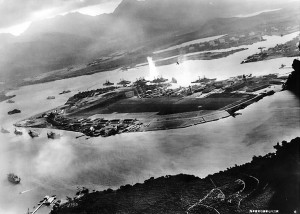 Located in the middle of Pearl Harbor is an island 335 acres in size. In Hawaii’s early days, it was known as Mokuumeume, meaning Island of Strife. It amazes me just how close that name is to the reality that is the island that is now known as Ford Island. I don’t think that strife is a constant companion of the island, but on this day, December 7, 1941…the date that will live in infamy, Ford Island was at center stage as one of the worst attacks in history took place on American soil. The participants, from the American side anyway, would have most certainly have chosen not to be there…if they had been given a choice. The island had changed hands several times, before finally ending up as a part of the military installation that was Pearl Harbor.
Located in the middle of Pearl Harbor is an island 335 acres in size. In Hawaii’s early days, it was known as Mokuumeume, meaning Island of Strife. It amazes me just how close that name is to the reality that is the island that is now known as Ford Island. I don’t think that strife is a constant companion of the island, but on this day, December 7, 1941…the date that will live in infamy, Ford Island was at center stage as one of the worst attacks in history took place on American soil. The participants, from the American side anyway, would have most certainly have chosen not to be there…if they had been given a choice. The island had changed hands several times, before finally ending up as a part of the military installation that was Pearl Harbor.
Every year, as Pearl Harbor Remembrance Day comes around, I try to write a story about that dreadful day, and this year, while looking at Pearl Harbor on Google Earth, my thoughts turned to that little island that was at the center of the attack. How must those men have felt? Everything happened so fast. There wasn’t even time to get the planes in the air. While the ships were being bombed around them, the pilots, mechanics, and airfield crew could only stand around watching…and dodging bullets. Of course, for most of them, that was impossible. The death toll that horrific day was 2403. In addition, there were 1178 people wounded. The emotional toll was beyond the imagination. This was the event that finally brought the United States into World War II.
I began to wonder what the people who were there were thinking as the events of the attack unfolded. There was no way to get off the island. If they had tried, they would surely have been killed. There were bombs going off on all sides of the island. Ships were sinking, airplanes were destroyed, and buildings were on fire or blown up. It was as if the world was coming to an end…or in reality, it was like waking up and finding yourself literally in Hell. My mind struggled to imagine how they must have felt…wishing and praying that all this was a dream and that they could be somewhere else…anywhere else. Still, they knew that it was real, and they were there, and 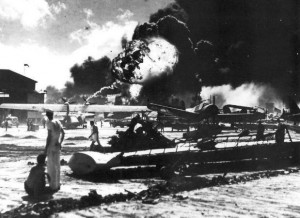
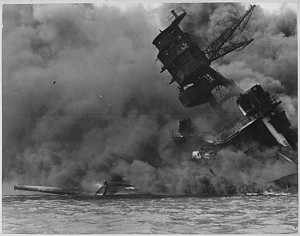 nothing would ever be the same again. They knew that the world as they had known it, had vanished…never to exist again. Of course, our country would come back from this attack, because we are a resilient people, but we would never be the same. We were less trusting of our enemies, something I see again in this day and age of terrorism, and something I think is important.
nothing would ever be the same again. They knew that the world as they had known it, had vanished…never to exist again. Of course, our country would come back from this attack, because we are a resilient people, but we would never be the same. We were less trusting of our enemies, something I see again in this day and age of terrorism, and something I think is important.
Being too trusting of our enemies in December of 1941, was exactly what paved the way for a surprise attack on December 7, 1941, and being too trusting today could do the same thing. It is imperative that we protect our people at all costs…even if it makes us seem heartless now. As in the case of the attack on Pearl Harbor, second chances at protecting our people don’t usually come. By the time we realize that we have made a mistake, it is too late, because it has become a fatal mistake. The men and women who survived the attack on Pearl Harbor knew first hand that our enemies hate us and want nothing less that death for America. That, I believe is the valuable lesson the people who survived that horrific attack took away that fateful day, and one we all need to seriously consider today.
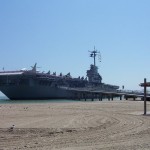 While Bob and I were in Corpus Christi, Texas in March of 2006, we had the opportunity to visit the USS Lexington, better known now, as The Blue Ghost. The ship was originally known as the Cabot, but after the USS Lexington CV-2 was lost in the Battle of the Coral Sea, she was renamed while under construction to commemorate the earlier USS Lexington. This Lexington was the fifth United States Navy ship to bear the name in honor of the Revolutionary War Battle of Lexington. In June of 1942, after the earlier USS Lexington was destroyed, workers at the shipyard submitted a request to Navy Secretary Frank Knox to change the name of a carrier currently under construction there to Lexington. Knox agreed to the proposal and Cabot was renamed as the fifth USS Lexington on 16 June 1942. She was launched on 23 September 1942, sponsored by Mrs Theodore Douglas Robinson. Lexington was commissioned on February 17, 1943.
While Bob and I were in Corpus Christi, Texas in March of 2006, we had the opportunity to visit the USS Lexington, better known now, as The Blue Ghost. The ship was originally known as the Cabot, but after the USS Lexington CV-2 was lost in the Battle of the Coral Sea, she was renamed while under construction to commemorate the earlier USS Lexington. This Lexington was the fifth United States Navy ship to bear the name in honor of the Revolutionary War Battle of Lexington. In June of 1942, after the earlier USS Lexington was destroyed, workers at the shipyard submitted a request to Navy Secretary Frank Knox to change the name of a carrier currently under construction there to Lexington. Knox agreed to the proposal and Cabot was renamed as the fifth USS Lexington on 16 June 1942. She was launched on 23 September 1942, sponsored by Mrs Theodore Douglas Robinson. Lexington was commissioned on February 17, 1943.
I can’t say for sure if this Frank Knox was any relation to my husband’s Knox ancestors, but it wouldn’t 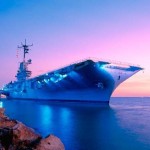 surprise me at all, since the Knox family was into politics, and even included a connection to President James Knox Polk. While I was originally writing this because on this day, December 5, 1941, the prior USS Lexington headed out to the Battle of Midway…a battle that it never made it to, because of the Japanese attack on Pearl Harbor. That Lexington made it back to Pearl Harbor on December 13, 1941, so it was not much help. Later, the prior USS Lexington was destroyed in the Battle of Coral Sea, triggering the renaming of the USS Lexington that Bob and I saw.
surprise me at all, since the Knox family was into politics, and even included a connection to President James Knox Polk. While I was originally writing this because on this day, December 5, 1941, the prior USS Lexington headed out to the Battle of Midway…a battle that it never made it to, because of the Japanese attack on Pearl Harbor. That Lexington made it back to Pearl Harbor on December 13, 1941, so it was not much help. Later, the prior USS Lexington was destroyed in the Battle of Coral Sea, triggering the renaming of the USS Lexington that Bob and I saw.
The USS Lexington we saw was referred to as a “ghost” ship by the Japanese for her tendency to reappear after reportedly being sunk. This, coupled with the ship’s dark blue camouflage scheme, led the crew to refer to her as “The Blue Ghost”. There were rumors during the war that the ship was so badly damaged it had to be scuttled at one point, but a newly built aircraft carrier was immediately deployed with the same name, in an effort to demoralize the Japanese. I’m sure the whole situation was a serious frustration to the Japanese, but for Bob and me the legend that ship had 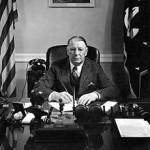 become was something we found quite interesting.
become was something we found quite interesting.
That said, I now find something new to draw my interest…namely Navy Secretary Frank Knox. One thing I have noticed is that in many families, certain names seem to be used over and over. In Bob’s family, there is a Frank Knox, and in that lineage there are Williams and Johns. The same is the case with Navy Secretary Frank Knox’s lineage. For that reason, I expect that a connection exists, and with a little work, I think I will find it, if it exists. I like the challenges that come from trying to connect the missing links in our family, and when I can tie it to something I have personally seen, it is an even more exciting quest.
 Since my dad was stationed in England during World War II, and because many of my ancestors come from England, I am interested in all things English. Of course, that doesn’t mean that I know everything about England, and I think it would be pretty difficult to do that with any country, including the country I live in…the United States. That said, I learned something about England today. England is an island nation as most people know, and that can make travel to mainland Europe difficult and expensive. Travel to Hawaii would be a good example of that, and Hawaii isn’t even it’s own nation. Nevertheless, most of us have to save up our money to make the trip to Hawaii.
Since my dad was stationed in England during World War II, and because many of my ancestors come from England, I am interested in all things English. Of course, that doesn’t mean that I know everything about England, and I think it would be pretty difficult to do that with any country, including the country I live in…the United States. That said, I learned something about England today. England is an island nation as most people know, and that can make travel to mainland Europe difficult and expensive. Travel to Hawaii would be a good example of that, and Hawaii isn’t even it’s own nation. Nevertheless, most of us have to save up our money to make the trip to Hawaii.
So, what does that have to do with England, you might ask. Well…everything. While an alternate mode of transportation to get to Hawaii…other than ship or plane, is not feasible for Hawaii…for England, maybe it could be. As early as the days of Napoleon Bonaparte, in 1802, people were looking for a way to connect England to France. Nothing came of those early suggestions, because the necessary technology was not available until the 20th century. The proposal was that since England and France were no longer at war, they should permanently connect their countries by way of a tunnel. The Channel Tunnel, later dubbed the Chunnel runs from Folkestone, England to Calais, France. The tunnel is 31 miles across, but in total there are 95 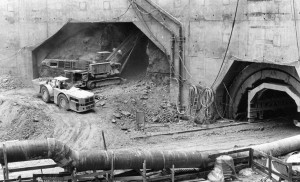 miles of tunnels. There are two railway tunnels, and a service tunnel. The work began on in 1986, and took four years to connect the two sides. Approximately 13,000 workers dug the 95 miles of tunnels at an average depth of 150 feet below sea level. Eight million cubic meters of soil were removed, at a rate of about 2,400 tons per hour. When it was finished, the Chunnel would have three interconnected tubes, including one rail track in each direction and one service tunnel. It cost $15 billion to complete.
miles of tunnels. There are two railway tunnels, and a service tunnel. The work began on in 1986, and took four years to connect the two sides. Approximately 13,000 workers dug the 95 miles of tunnels at an average depth of 150 feet below sea level. Eight million cubic meters of soil were removed, at a rate of about 2,400 tons per hour. When it was finished, the Chunnel would have three interconnected tubes, including one rail track in each direction and one service tunnel. It cost $15 billion to complete.
Most of us don’t give much thought to tunnels, but when it comes to underwater tunnels…well, that is just different. Of course, we all know of the Holland Tunnel that connects New York and New Jersey, but that tunnel isn’t nearly as long as the Chunnel. The Holland Tunnel is a little over a mile and a half, which pales by comparison to the Chunnel’s 31 miles. On December 1, 1990, after four long years of work, the two sides of the Chunnel were connected. Workers exchanged French and British flags and toasted each other with champagne. It was a great day. The Channel Tunnel finally opened for passenger service on May 6, 1994, with Britain’s Queen Elizabeth II and France’s President Francois Mitterrand on hand in Calais for the inaugural run. A company called Eurotunnel won the 55 year contract to operate the Chunnel, which is the crucial stretch of the  Eurostar high speed rail link between London and Paris. The regular shuttle train through the tunnel runs 31 miles in total, with 23 of those underwater and it takes 20 minutes, with an additional 15 minute loop to turn the train around. The Chunnel is the second-longest rail tunnel in the world, after the Seikan Tunnel in Japan.
Eurostar high speed rail link between London and Paris. The regular shuttle train through the tunnel runs 31 miles in total, with 23 of those underwater and it takes 20 minutes, with an additional 15 minute loop to turn the train around. The Chunnel is the second-longest rail tunnel in the world, after the Seikan Tunnel in Japan.
Things like this fascinate me. I like the idea of something as unique as the Chunnel. I like the interesting fact that it is in England. And I like the fact that, the Chunnel is the longest underwater section, longest international tunnel, second-longest railway tunnel in the world. Some day, I hope to ride the train through that tunnel. Wouldn’t that be amazing?
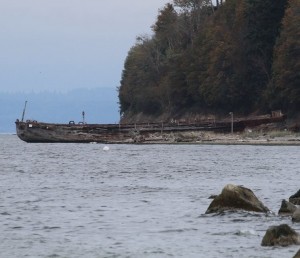 After Bob and I had the opportunity to view the old minesweeper, now located off Picnic Park near Edmonds, Washington, I have been curious about mines and minesweepers, in general. That said, I did a little research on them, and was surprised at what I found. Landmines have been in existence since the early Ming Dynasty in the 1400s. It seems such a strange thing to me to set explosives in areas where they could not only trigger an explosion when an enemy crosses paths with them, but they could also trigger explosions when their own citizens crossed paths with them. I suppose those accidental friendly hits would be considered collateral damage, and were acceptable losses in the grand scheme of things, but it still seems like a horrible way to guard an area. Still, it was definitely an effective way to guard and area, border, or waterway.
After Bob and I had the opportunity to view the old minesweeper, now located off Picnic Park near Edmonds, Washington, I have been curious about mines and minesweepers, in general. That said, I did a little research on them, and was surprised at what I found. Landmines have been in existence since the early Ming Dynasty in the 1400s. It seems such a strange thing to me to set explosives in areas where they could not only trigger an explosion when an enemy crosses paths with them, but they could also trigger explosions when their own citizens crossed paths with them. I suppose those accidental friendly hits would be considered collateral damage, and were acceptable losses in the grand scheme of things, but it still seems like a horrible way to guard an area. Still, it was definitely an effective way to guard and area, border, or waterway.
Nevertheless, I can understand why countries such as England, who is surrounded by water, and therefore vulnerable to certain types of attacks, especially during the earlier wars, like World War I and World War II, might have decided as they did in World War II, to lay mine traps to guard against movement by the German U-Boats in World War II. The U-Boats were feared by all their enemies, and considered one of the biggest dangers in the war by Winston Spencer Churchill. They made it almost impossible to have any prior knowledge of their presence, until it was too late to get away from them. Still, putting mines in the English Channel, where your own ships had to maneuver too, almost seems like taking a risk that would be greater than the benefit that it provided. Nevertheless, submarine traps were laid in the English Channel, and they served a purpose.
When considering a minesweeper in World War II, when ships were made of metal, I was curious as to why there would be a wooden hulled minesweeper in World War II. It has come to my attention that the minesweeper in Edmonds, may not have seen action at all. There seems to be a bit of confusion as to when it was built, and when it came to it’s final resting place in the Edmonds area. If it was indeed built for World War II, and never saw action, then my thought was why was it a wooden hull. I found the answer to that in my research on mines. There are several types of mines, as I mentioned earlier. Landmines were the earliest, but when it came to floating mines, they were mostly magnetic. Now when you put a metal minesweeper, or any other metal ship or submarine, near a magnetic mine…well, I’m sure you can get a picture of the seriousness of the problem they would have. A wooden hulled minesweeper on the other hand would have to actually come into contact with the mine to have that problem. Perhaps this was the reason for mines laid under the surface of the water and held in place by a cable. They were more invisible to the eye, and so created the ability to trigger the explosion when an unsuspecting ship or submarine found themselves in the wrong place. These mines blew a hole in the hull, rendering the ship or submarine helpless, as it took on water and quickly sunk.
There have been stories in the news over the years, of mines showing up on the shore years after they were 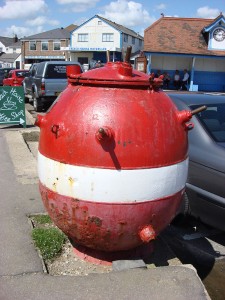 laid. It was a big problem, as were the landmines that were left after the wars. No clear record were kept apparently, and so removal of the mines was never made a priority. I remember when Princess Diana made it one of her priorities to find a way to get those landmines removed. The injuries to so many people who wandered into a minefield just tore at her heart. In hearing about the stories of tragedies resulting from those minefields, my mind cringed at the thought of those injuries. I found myself thinking that her quest to remove them was such an important one. Because I love to hike, I can see how easy it could be to create a trail that would cross paths with a minefield that has been around for decades. Sometimes, the necessary weapons of our warfare bring such destruction, that you find yourself wondering why people and nations can’t just get along, but we all know that is not to be. As long as there has been life on Earth, there have been wars of one kind or another, and I don’t expect that to change now, so these weapons will continue to exist and to be a big problem.
laid. It was a big problem, as were the landmines that were left after the wars. No clear record were kept apparently, and so removal of the mines was never made a priority. I remember when Princess Diana made it one of her priorities to find a way to get those landmines removed. The injuries to so many people who wandered into a minefield just tore at her heart. In hearing about the stories of tragedies resulting from those minefields, my mind cringed at the thought of those injuries. I found myself thinking that her quest to remove them was such an important one. Because I love to hike, I can see how easy it could be to create a trail that would cross paths with a minefield that has been around for decades. Sometimes, the necessary weapons of our warfare bring such destruction, that you find yourself wondering why people and nations can’t just get along, but we all know that is not to be. As long as there has been life on Earth, there have been wars of one kind or another, and I don’t expect that to change now, so these weapons will continue to exist and to be a big problem.
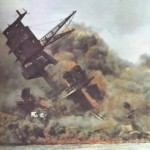
 World War II had been raging since September 1, 1939. It was without doubt the most destructive war in history. Some say it was simply a continuation of World War I, that had ended in 1918. Others will blame the 1931 Japanese seizure of Manchuria from China, or Italy’s invasion and defeat of Ethiopia in 1935, or Adolf Hitler’s re-militarization of Germany in 1936, or the Spanish Civil War 1936 to 1939, or Germany’s occupation of Czechoslovakia in 1938 as possible beginnings. But, the two dates most often mentioned as “the beginning of World War II” are July 7, 1937, when the “Marco Polo Bridge Incident” led to war between Japan and China, and September 1, 1939, when Germany invaded Poland, which led Britain and France to declare war on Hitler’s Nazi state in retaliation. To me it would seem that the tensions that had begun before World War I, simply never went away. It would seem that there were many world leaders who were power hungry, and greedy for the lands that belonged to their neighbors. And when you look at the Middle East today, maybe not much has really changed.
World War II had been raging since September 1, 1939. It was without doubt the most destructive war in history. Some say it was simply a continuation of World War I, that had ended in 1918. Others will blame the 1931 Japanese seizure of Manchuria from China, or Italy’s invasion and defeat of Ethiopia in 1935, or Adolf Hitler’s re-militarization of Germany in 1936, or the Spanish Civil War 1936 to 1939, or Germany’s occupation of Czechoslovakia in 1938 as possible beginnings. But, the two dates most often mentioned as “the beginning of World War II” are July 7, 1937, when the “Marco Polo Bridge Incident” led to war between Japan and China, and September 1, 1939, when Germany invaded Poland, which led Britain and France to declare war on Hitler’s Nazi state in retaliation. To me it would seem that the tensions that had begun before World War I, simply never went away. It would seem that there were many world leaders who were power hungry, and greedy for the lands that belonged to their neighbors. And when you look at the Middle East today, maybe not much has really changed.
Wherever you place the beginning of World War II, you would agree that while the Japanese and the Germans may not have been war weary, the rest of the world really was. Before the Japanese attacked Pearl Harbor on December 7, 1941, the United States had somehow managed to stay out of the conflict. Whether that was right or wrong is a matter of opinion too. Nevertheless, when the Japanese brought the war to our front door, the United States answered with a vengeance. I’m sure the allies were glad to have the reinforcements, but also wondered why it had taken so long for us to get involved. Sometimes, I have wondered that myself, about that and other wars that we have come into just a little bit late in the game.
That said, we got into the war, and I believe that the extra military might that the United States brought to the Allied Forces was the tipping point in the war, because a war that had officially raged since September 1, 1939, was brought to an end on September 2, 1945, when Victory over Japan was celebrated in the United States. Japanese troops finally surrendered to Americans on the Caroline, Mariana, and Palau islands. Representatives of their emperor and prime minister were preparing to formalize their declaration of defeat. In Tokyo Bay, aboard the Navy battleship USS Missouri, Japanese foreign minister, Mamoru Shigemitsu and chief of staff of the Japanese army, Yoshijiro Umezu, signed the “instrument of surrender.” General Douglas MacArthur, commander of the US Army forces in the Pacific, and Admiral Chester Nimitz, commander of the US Pacific Fleet were there to represent the Allied victors.
After the surrender, Mamoru Shigemitsu was found guilty of war crimes. He was sentenced to seven years in prison. Oddly, it was he who had fought for concessions on the Japanese side in an attempt to secure an early peace. He was paroled in 1950 and went on to become chairman of Japan’s Progressive Party. General 
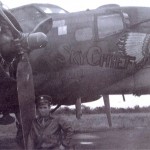 MacArthur would come up against him again when he was named commander in chief of the United Nations forces in Korea in 1950. For some people, it would seem, that one defeat simply isn’t enough, but that is another story. Today is VJ Day…Victory over Japan Day. It may not be a day that we remember as well as we do D Day, which simply stands for the day designated to storm the beaches at Normandy, or the attack on Pearl Harbor, but VJ Day is in reality as important a day as those others too, because it was the day that ended the world’s worst, and most destructive war.
MacArthur would come up against him again when he was named commander in chief of the United Nations forces in Korea in 1950. For some people, it would seem, that one defeat simply isn’t enough, but that is another story. Today is VJ Day…Victory over Japan Day. It may not be a day that we remember as well as we do D Day, which simply stands for the day designated to storm the beaches at Normandy, or the attack on Pearl Harbor, but VJ Day is in reality as important a day as those others too, because it was the day that ended the world’s worst, and most destructive war.
 My nephew, Steve Spethman, who married my niece, Jenny Masterson Spethman, is probably one of the most helpful people I know. In the almost thirteen years they have been married, Steve has proven himself to be not only a great husband and father, but such a help to our entire family. He is not afraid of hard work or heavy lifting, and we have counted on him many times in those years. Steve’s strength has been there for us from helping with my mom, Collene Spencer, to building decks and such, to simply reaching that thing we needed that was out of our reach. Steve could always be counted on. He never acted like it was a bother or a burden to help out either. He simply stepped in where needed, and that made all the difference. My mom said more than once just how safe she felt when Steve was helping her, and that is saying something, because when you don’t feel safe to stand or walk, it is very important to have someone there who is able to help.
My nephew, Steve Spethman, who married my niece, Jenny Masterson Spethman, is probably one of the most helpful people I know. In the almost thirteen years they have been married, Steve has proven himself to be not only a great husband and father, but such a help to our entire family. He is not afraid of hard work or heavy lifting, and we have counted on him many times in those years. Steve’s strength has been there for us from helping with my mom, Collene Spencer, to building decks and such, to simply reaching that thing we needed that was out of our reach. Steve could always be counted on. He never acted like it was a bother or a burden to help out either. He simply stepped in where needed, and that made all the difference. My mom said more than once just how safe she felt when Steve was helping her, and that is saying something, because when you don’t feel safe to stand or walk, it is very important to have someone there who is able to help.
Steve’s military service was in the Marines, and that left him with a great interest in the different wars. I think 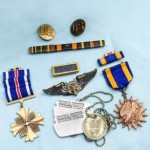 his favorite one might be the same as mine…World War II. He loves all things military, from planes to medals, but World War II is of particular interest. As my sisters and I have been going through our parents’ things, we found the military uniforms dad had and the medals he earned. Finding them and knowing what they were for are two different things, however. Steve researched what they were for. That gave us a whole new insight into all that our dad did in the war. Just looking at medals, or even looking at the discharge papers, doesn’t really tell you what really took place with each one. Of course, to really understand, we will each have to research the events of that war in which our dad took part, but Steve has given us a place to begin. I love talking with Steve about military things, because he has a unique perspective on it all. Having never been in the service, I would really have no idea about it all, other than the research I have done and the conversations I have been fortunate enough to have with military personnel or retired military personnel over the years.
his favorite one might be the same as mine…World War II. He loves all things military, from planes to medals, but World War II is of particular interest. As my sisters and I have been going through our parents’ things, we found the military uniforms dad had and the medals he earned. Finding them and knowing what they were for are two different things, however. Steve researched what they were for. That gave us a whole new insight into all that our dad did in the war. Just looking at medals, or even looking at the discharge papers, doesn’t really tell you what really took place with each one. Of course, to really understand, we will each have to research the events of that war in which our dad took part, but Steve has given us a place to begin. I love talking with Steve about military things, because he has a unique perspective on it all. Having never been in the service, I would really have no idea about it all, other than the research I have done and the conversations I have been fortunate enough to have with military personnel or retired military personnel over the years.
Of course, Steve’s top priority is his family. His wife, Jenny, who is my niece is the love of his life. He has five  wonderful children, Xander, Zachary, Isaac, Laila (who lives in Heaven), and Aleesia. Steve loves his wife and kids more than life itself. Steve is a great dad. He loves doing things with his kids. He has taught his boys to shoot, and to be safe with a gun, and plans to go hunting with eldest son, Xander this year. It will be a great adventure for them. It is always a wonderful thing when you see someone who is willing to give their all for someone else. With so many people these days in selfish mode, it is almost unusual to see someone in selfless mode. Our world has become one of “what can you do for me” people. Steve is not like that. He is a “what can I do for you person” and he always has been. How very refreshing that is. Today is Steve’s birthday. Happy birthday Steve!! Have a great day!! We love you!!
wonderful children, Xander, Zachary, Isaac, Laila (who lives in Heaven), and Aleesia. Steve loves his wife and kids more than life itself. Steve is a great dad. He loves doing things with his kids. He has taught his boys to shoot, and to be safe with a gun, and plans to go hunting with eldest son, Xander this year. It will be a great adventure for them. It is always a wonderful thing when you see someone who is willing to give their all for someone else. With so many people these days in selfish mode, it is almost unusual to see someone in selfless mode. Our world has become one of “what can you do for me” people. Steve is not like that. He is a “what can I do for you person” and he always has been. How very refreshing that is. Today is Steve’s birthday. Happy birthday Steve!! Have a great day!! We love you!!
 Over the thousands of years since man has been on the Earth, amazing people, as well as evil people, have made memorable speeches. Some speeches were never expected to be memorable or historic, and others were expected to be so, because they were designed to be uplifting, inspirational, morale building, or a tribute filled with gratitude. It was the latter that inspired Sir Winston Spencer Churchill to make his speech on August 20, 1940. Europe was entrenched in World War II and things weren’t going as well as they had hoped. They had taken a few rather large beatings from the Germans, and morale was not as high as they had hoped. The speech was given as the United Kingdom prepared for the expected German invasion. After a series of defeats for the Allies over the prior months, Churchill was trying to tell the people that they were in a much better position now. He was correct, of course. Shortly after the speech, the British won the battle, the first significant defeat for the previously unstoppable Wehrmacht.
Over the thousands of years since man has been on the Earth, amazing people, as well as evil people, have made memorable speeches. Some speeches were never expected to be memorable or historic, and others were expected to be so, because they were designed to be uplifting, inspirational, morale building, or a tribute filled with gratitude. It was the latter that inspired Sir Winston Spencer Churchill to make his speech on August 20, 1940. Europe was entrenched in World War II and things weren’t going as well as they had hoped. They had taken a few rather large beatings from the Germans, and morale was not as high as they had hoped. The speech was given as the United Kingdom prepared for the expected German invasion. After a series of defeats for the Allies over the prior months, Churchill was trying to tell the people that they were in a much better position now. He was correct, of course. Shortly after the speech, the British won the battle, the first significant defeat for the previously unstoppable Wehrmacht.
Times of war are often when great men make speeches to inspire the military troops to persevere. They can be a battle cry of sorts. Or they can be a reflection of such deep gratitude that it leaves us awestruck. Churchill was first moved to utter those famous words upon his exit from the Battle of Britain Bunker at RAF Uxbridge on August 16, 1940. He had been the Number 11 Group RAF Operations Room during a day of battle. Afterwards, Churchill told Major General Hastings Ismay, “Don’t speak to me, I have never been so moved.” His emotions were so deep, that he had to think about this for a time. The two were silent for a few moments, and then Churchill said, “Never in the field of human conflict has so much been owed by so many to so few.” That declaration became the basis of his speech to the House of Commons on August 20, 1940.
In his speech, Winston Churchill said, “The gratitude of every home in our Island, in our Empire, and indeed throughout the world, except in the abodes of the guilty, goes out to the British airmen who, undaunted by odds, unwearied in their constant challenge and mortal danger, are turning the tide of the World War by their prowess and by their devotion. Never in the field of human conflict was so much owed by so many to so few. All hearts go out to the fighter pilots, whose brilliant actions we see with our own eyes day after day, but we must never forget that all the time, night after night, month after month, our bomber squadrons travel far into Germany, find their targets in the darkness by the highest navigational skill, aim their attacks, often under the heaviest fire, often with serious loss, with deliberate, careful discrimination, and inflict shattering 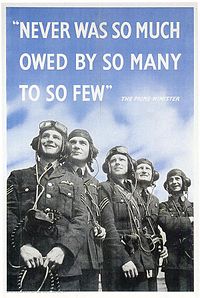 blows upon the whole of the technical and war-making structure of the Nazi power. On no part of the Royal Air Force does the weight of the war fall more heavily than on the daylight bombers who will play an invaluable part in the case of invasion and whose unflinching zeal it has been necessary in the meanwhile on numerous occasions to restrain…”
blows upon the whole of the technical and war-making structure of the Nazi power. On no part of the Royal Air Force does the weight of the war fall more heavily than on the daylight bombers who will play an invaluable part in the case of invasion and whose unflinching zeal it has been necessary in the meanwhile on numerous occasions to restrain…”
Words can be so powerful. They have the power to change the course of history when they are used to inspire soldiers in battle to a victory that seemed impossible just moments before the words were spoken. Sometimes, all it takes to bring about a victory is to listen to the one person who sees that victory, no matter how many defeats have preceded it, is still possible. Great men…men who have inspired victory…have been around a long time. These men, and women too, refuse to accept defeat. And they have the ability to speak powerfully to convince others that victory can follow defeat.

